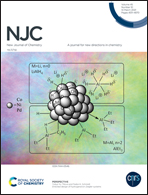Structures and mechanisms of CO2 cycloaddition with styrene oxide on bimetallic M–Cu–BTC MOFs (M = Mg, Ca, Al, and Ga): a DFT study†
Abstract
DFT calculations (M06-L functional) were used to investigate the structure and electronic properties of bimetallic M–Cu–BTC paddlewheels (M = Mg, Ca, Al, and Ga) and their catalytic activity for CO2 cycloaddition with styrene oxide (SO) in the absence of a co-catalyst. The electrostatic interactions play a vital role in the CO2 and SO adsorptions on the metal center of the bimetallic paddlewheels. The appearance of the substituted metal is strongly dominated in the adsorption of SO and CO2 molecules on the Cu center of the bimetallic paddlewheels. The free energy of adsorption increases from −1.7 (Ca–Cu–BTC) to −10.7 (Ga–Cu–BTC) kcal mol−1 for SO adsorption on the Cu site of the M–Cu–BTC paddlewheels. Highly exposed Cu active site in the cases of Al–Cu–BTC and Ga–Cu–BTC is the key to activating the SO in the chemical reaction compared to the Cu center of Mg–Cu–BTC and Ca–Cu–BTC nodes. The substituted metal centers are revealed as key active sites for the CO2 cycloaddition with SO in the absence of a co-catalyst. The stronger interaction of an SO molecule on the substituted metal center as compared to that on the Cu site in the corresponding systems promotes the polarization of the C–O σ-bond of the adsorbed SO, facilitating the CO2 cycloaddition reaction efficiently. Among them, the Al site of the bimetallic Al–Cu–BTC paddlewheel is a candidate catalyst for CO2 cycloaddition with SO. The SO molecule is strongly adsorbed on the Al site of Al–Cu–BTC with the free energy of −29.0 kcal mol−1. The Cα–O bond length of adsorbed SO increases from 1.425 to 1.492 Å. The activation free energies  of the concerted reaction were calculated to be 29.9 and 36.4 kcal mol−1 for the catalytic process on the Al and Cu centers of the bimetallic Al–Cu–BTC paddlewheel.
of the concerted reaction were calculated to be 29.9 and 36.4 kcal mol−1 for the catalytic process on the Al and Cu centers of the bimetallic Al–Cu–BTC paddlewheel.



 Please wait while we load your content...
Please wait while we load your content...